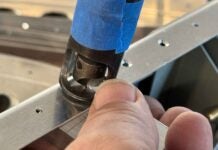No matter how many different tools you have, you always need something else – or at least something slightly different. This is particularly true when it comes to rivet squeezer yokes. These things cost close to $200 each, so you try to cover the spectrum of uses with as few as possible. I have three portables that I use most of the time, and two that are mounted on stands (they weigh 400 lbs) – but there are still cases where you just need something slightly different – so you have to get creative.

Yesterday I was squeezing a couple of rivets in a very narrow spot inside the rear spar of the F1 Rocket left elevator – the part that is immediately ahead of the trim tab. A No—Hole yoke is mandatory because you have very little room (1” maybe) between the spar flanges. But you also have a hinge “loop” to get over, so you need just a little rise to prevent smashing that. I could have drilled a hole in my No-Hole and using a thin flat die – but then I wouldn’t have a no-hole anymore!

The solution – I needed a thin flat die taped to the no-hole – but I didn’t want tape between the yoke face and the tail of the rivet. So I looked on the floor and found the head of an AN-3 I had cut off for some reason. I flattened and polished the stub of the bolt shank. Then I took a piece of duct tape and drilled a hole in it, allowing the bolt shank (now a squeezer die!) to stick through, then taped that to the no-hole. This effectively gave me an extremely shallow Longeron Yoke that fit in the narrow space but gave me an offset.
You do whatever it takes to- especially since no one makes a yoke like what I needed. Be creative, think the problem through – and take a look at the scraps on your shop floor for inspiration













